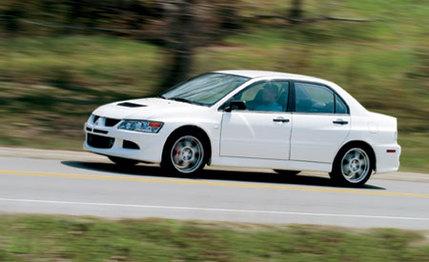
 Short Take Road Test
TESTED
Short Take Road Test
TESTED
The Mitsubishi Lancer Evolution is a rough and raw small sedan. There's no denying its ride is as stiff as a forearm shiver and its high-boost turbocharged four-cylinder as punchy as Oscar de la Hoya. But if one can deal with the punishment, the Evo rewards the driver with a beautifully balanced chassis, one that serves up lofty levels of grip, acceleration, and handling—all for $30,574. Plus, it can be argued that the Evo makes an acceptable daily driver, what with its standard keyless entry, CD player, and power mirrors, windows, and door locks.
But take away those amenities, and what have you got? The $27,374 Evolution RS pictured here, which is a faster, more furious Evo that's as rough as its brother, but even cruder.
The RS gives up all comfort and civility in the name of saving weight, denting the dirt with 234 fewer pounds than the standard Evo. Of course, eliminating keyless entry, a CD player, and the power goodies doesn't shed enough weight to make a performance point, so the RS must also leave the factory without the standard model's sound-deadening material, trunk lining, anti-lock brake system, rear wing, rear-window wiper, high-intensity-discharge headlamps, and just about every interior practicality, including the vanity mirrors, rear assist grips, and map lights. Even the door handles and side mirrors lack the weight of paint. Our tester was without an air conditioner as well. Mitsubishi later decided that all '04 RSs would be fitted with that convenience. So with A/C, we reckon the RS would be somewhat closer to Mitsu's 3175-pound estimate.


Although the RS is blessed with less weight, it hasn't been given more power. It's motivated by the same 271-hp, 2.0-liter turbo four and five-speed manual that propel the standard Evo. That's fine by us, seeing that the heavier, standard model is capable of 0 to 60 mph in 5.0 seconds and the quarter-mile in 13.6 at 101 mph ["New-Wave Slingshots," C/D, June 2003]. Pulling a lighter load, the RS scorched to 60 in 4.8 and through the quarter in 13.5 at 102. If you had an extra $21,421 lying around, you could buy a 333-hp BMW M3, but you wouldn't be any quicker to 60 or the quarter ["Compact Adrenaline-Delivery Systems," C/D, May 2003].
Unlike its more civilized brother, the RS is equipped with a front helical-type limited-slip differential that Mitsubishi claims is better for aggressive turning than the standard Evo's open unit. We weren't able to push the RS to its limits to really attest to the LSD's efficacy—we didn't have a chance to take it to a racetrack, either—nevertheless, its superior skidpad number (0.92 g versus 0.90 g) illustrates the helical diff's ability to effectively deliver more power to the front Yokohama with the most grip, thus improving threshold turning.
On our local 10Best handling loop, the RS felt every bit as agile and quick on its feet as the standard Evo, but it added a 10th to the limit meter. It feels more buttoned to the road than its "luxury" mate, especially at the rear, thanks most likely to a new extruded-aluminum crossbar just aft of the rear seats. Visible with the trunk lid up, the crossbar stiffens the rear structure and helps keep the hind end planted, making the RS easier and less hairy to rocket out of corners. Into and out of high-speed sweepers, the RS just keeps saying, "Faster! Faster!" Turns normally taken at 70 mph didn't seem threatening at 90. Braking remains excellent as well, with the front and rear Brembo calipers erasing 70 mph in a scant 167 feet, but that's still 10 feet longer than the standard car's distance with ABS.
As a daily driver, the RS is maybe not the greatest idea. Conveniences that are commonplace in $10,000 econoboxes are absent. And without any sound deadening, the buzz from the engine seems like a murmur compared with the rock concert from pebbles, dirt, sand—anything, really—rebounding off the undercarriage. Imagine crushing CornNuts in a steel-jug blender, and you get the idea.
But if you can put up with the noise, or if you're looking for the ultimate rally-car starter kit, it's tough to top the RS. And if somehow the 2004 RS's numbers don't impress you, the '05's most likely will. This fall, the RS gets five more horsepower (up to 276), 13 additional pound-feet of torque (to 286), an electronic active center differential, and for reduced body weight, an aluminum roof and thinner sheetmetal and backlight glass.
In many ways, the RS is the four-door equivalent of the Lotus Elise—as raw as a skinned knee, but bleeding never felt so good.